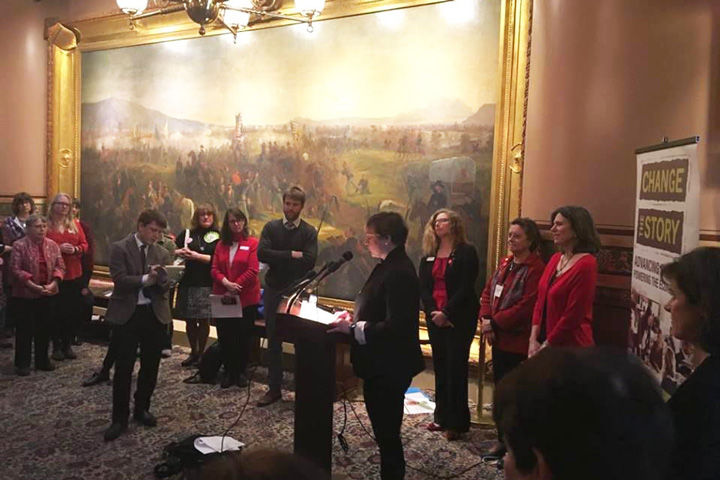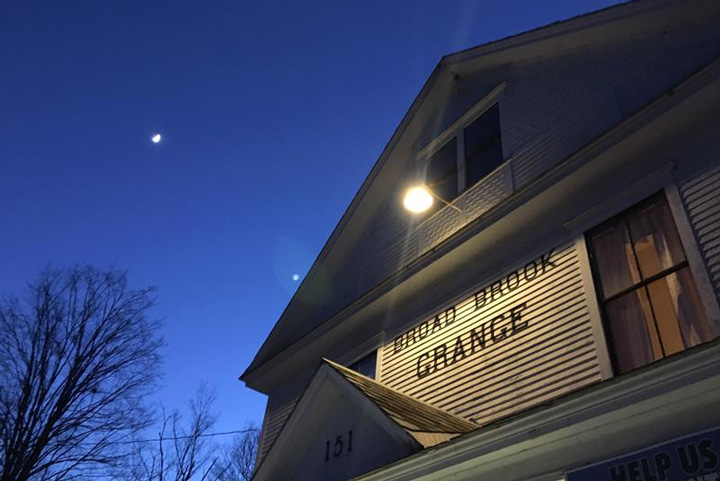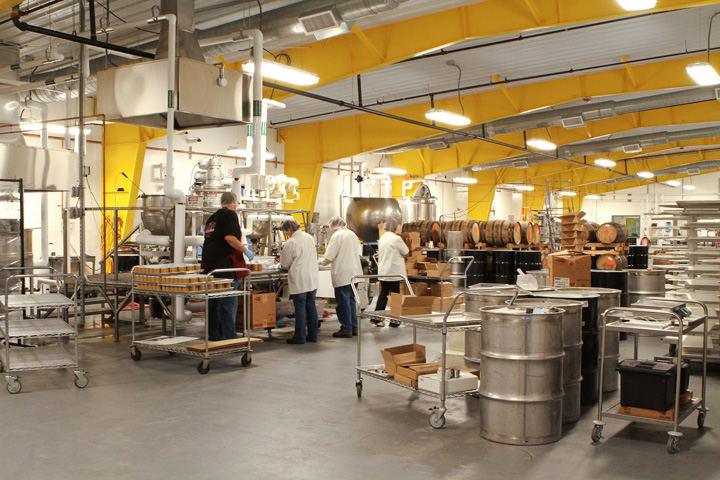
by Kelsey Price | Apr 5, 2019 | Diversity, News, Workforce Training
In a 2016, the New American Economy reported that, as a whole, New Americans in Vermont earned $654.7M in 2014. These employees work for hundreds of Vermont businesses, and many of these employers are instituting programs designed to improve their employees’ skills and earning power.
One such employer is Birnn Chocolates of South Burlington. With several long serving, non-native employees, the owners of the company have instituted English language learning courses for their staff during work hours, to help them improve their language skills while not taking time away from their families. The result is more skilled and loyal workers, and also better communication, production, and company culture.
Bhuwan Sharma, owner of Burlington Employment Agency, serves primarily the large Bhutanese-Nepali community of Burlington. While it is a challenging time for companies to find workers, Sharma has placed dozens of New American workers in jobs in the Burlington area. Other businesses such as Rhino Foods (the company that makes the cookie dough you’ll find in a pint of Ben & Jerry’s) employs large numbers of New Americans—37% of their workforce is comprised of New Americans.
Photo: Julia Birnn Fields, co-owner of Birnn Chocolates of South Burlington, stands before the Vermont State House with two of her New American employees, Shashika Sharma from Bhutan and Lizhi Li from China.

by Kelsey Price | Apr 2, 2019 | Central Vermont, Creative Economy, Diversity
Shanta is a multidisciplinary artist who transformed a challenging childhood into a creative career as a photographer, poet, investigative journalist, and advocate. Her education includes an undergraduate degree in women, gender, and sexuality as well as an MBA. She’s currently completing an MFA in creative nonfiction and poetry at the Vermont College of Fine Arts. She is also one of the managing editors and an editor of creative nonfiction for Mount Island, a literary magazine focused on rural LGBTQ and POC voices. Despite her busy schedule, Shanta found time to share some of her thoughts about being a Vermont Artist.
How has living as an artist in Vermont affected your creative process?
Vermont is where I first fell in love with the idea of photographing abandoned things. Also, I’ve re-engaged with my former urban landscape in my poetry and writing while also expanding new ways for me to see and appreciate other types of landscapes. Vermont gave me the opportunity to take chances to become, it is a fertile ground for risking.
What is something about your art that has changed over time?
For me, my art has shifted from being personal and private to something I had to share with others.
The funny thing about my writing is that I was first introduced to it as a punishment, not as art! As a punishment, my mother would assign me to write the sentences, “I will not ____” on sheets of paper until she told me to stop. In sixth grade, I had a teacher who would assign dictionary pages as punishment. Oddly, this did not deter me from writing. I would often stand at my windowsill in my room, and use the lights from the apartment buildings to write. I would’ve gotten in big trouble if it was discovered I was writing instead of sleeping. In this way, I was willing to risk a lot in order to express myself.
Photography has a bit of a different path. When I left for college, I stole my dad’s Nikon, but didn’t engage in using it as I should’ve. It was ultimately living in India for five months that prompted me to invest in a camera and do some travel writing that I shared with others. I did my first exhibition, Surrender, with my shots from India upon my return. The private-public shift in my creating also included taking opportunities that involved creating spaces or forums for others to engage in discussions about creativity.
I still walk between the tension of keeping my work to myself versus putting it into the world.
What is your vision for the next several years?
One of my goals includes thinking about the set of questions I would like my work either to pose, answer, or both, in my artistic work. I would like my work to inspire inquiry and critical thinking as well. I also am interested in eventually owning gallery space where I can continue to engage various communities with different forms of art. I want to continue to challenge myself by working in some of the new mediums that I’ve started to explore (like my watercolors). I also envision eventually publishing my photography, a book of poetry, and my memoir.
Watch an interview with Shanta on Brattleboro Community Television.
Watch a spoken word performance.
Read “Becoming the Cartographer of Her Own Life” in Ms. Magazine.
This story by the Vermont Arts Council originally appeared at https://www.vermontartscouncil.org/blog/i-am-a-vermont-artist-shanta-lee-gander/.

by Kelsey Price | Apr 2, 2019 | Diversity, Jobs, News
Governor Phil Scott today signed a proclamation recognizing April 2, 2019 as Equal Pay Day in Vermont, highlighting the gender pay gap between men and women’s earnings and the importance of promoting women’s equality in the workforce.
“Closing the wage gap will undoubtedly have many positive outcomes for Vermont. It could reduce Vermont’s poverty rate, generate millions in our state’s economy and help attract more working families to Vermont,” said Governor Scott. “More importantly, it would help put us one step closer to providing equality for all because that’s the right thing to do.”
According to the U.S. Census Bureau, Vermont’s gender wage gap is 14 cents, with women receiving an average of 86 percent of men’s earnings. Vermont currently ranks sixth in the nation for gender earnings ratio, a ratio that is even lower for women of color and women with disabilities.
“Vermont stands out in the country in the progress we’ve made bringing women’s wages up, but the health of our entire economy depends on making sure that all Vermonters’ contributions are valued, that everyone has access to opportunities that use their full talents, and that no one lags behind,” said Cary Brown, executive director of the Vermont Commission on Women. “Equal pay is an essential part of that picture.”
Governor Scott signed the proclamation at an Equal Pay Day event, joined by members of the Vermont Commission on Women, the Legislature and representatives from advocacy groups, including the League of Women Voters, Building Bright Futures, Evolve, Girl Scouts and the Women Business Owners Network.
The full proclamation can be viewed at https://governor.vermont.gov/content/equal-pay-day-proclamation-19-031.

by Kelsey Price | Mar 27, 2019 | Communities, Creative Economy, News, Quality of Life, Tourism & Hospitality
Across Vermont, communities are investing in historic, centrally located buildings in an effort to transform them into spaces where people can come together.
In January 2018, a community group in Guilford took ownership of the historic, 123-year-old Broad Brook Grange. The group recently completed phase one of renovations and is utilizing the building for community-wide events such as brunches and dinners. These types of renovations are happening throughout the state – Norwich volunteers are preparing to renovate Root Schoolhouse, a one room schoolhouse built in 1937, Marlboro just opened a community center in an old meeting house and Westford turned a nearly 120-year-old church into a performance venue.
Vermont towns are using restoration as a way to fight population decline while still maintaining their unique identity and community. This trend comes on the heels of the state’s strong push to expand Vermont’s population. One state initiative is the Stay to Stay Weekend program, which offers pre-planned weekends that encourage tourists to move to Vermont permanently.

by Kelsey Price | Mar 21, 2019 | Agriculture, Food & Beverage, News, VTP, Workforce Training
Runamok Maple and Sogle Property LLC (d/b/a Thunder Basin Maple Works) have been granted a combined $95,779.90 in Vermont Training Program (VTP) funds. Both companies are co-owned by Eric and Laura Sorkin and together tap 81,000 maple trees on 1,350 acres in Cambridge and Fairfield, Vermont. Production across both companies has doubled in size over the last year.
Thunder Basin Maple Works manages the sugarbush, providing sap to Runamok Maple for their line of award-winning maple products. The VTP grant will help Thunder Basin provide extensive training for new leadership in forestry skills, Game of Logging woods safety certification, and organic training certifications. Training will support the current workforce as well as new hires.
At Runamok Maple, the VTP grant will be used to provide additional training for new and existing employees on stringent food manufacturing guidelines and regulations; manufacturing software implementation; newly purchased equipment; and various other manufacturing programs.
With the maple industry’s continued growth and consumer trends increasing demand for natural sweeteners over synthetic counterparts, Runamok plans to expand offerings in the years ahead.
“At Runamok Maple and Thunder Basin training is at the core of our business strategy. Investments in our employees are directly correlated to our future success and VTP funding has provided us with additional capacity to make these investments,” said co-owner Eric Sorkin. “The Vermont Department of Economic Development has been very supportive and went above and beyond to help us. In short, they are a great partner.”
“Vermont maple syrup is both nationally acclaimed and deeply rooted in our culture here at home,” said Joan Goldstein, Commissioner of the Vermont Department of Economic Development, which oversees the Vermont Training Program. “It is a growth industry that is expanding the state’s workforce and heightening our reputation for producing high quality products. We are pleased to be able to support a growing Vermont company looking to the future.”
In 2018, Vermont produced nearly two million gallons of maple syrup, making the state the largest producer in the country.





